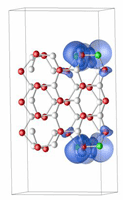Current Research Topics
![]()
- My research recently focuses on Dilute Magnetic Semiconductors (DMSs), a new class of materials where a magnetic impurity has been intentionally introduced. It has attracted much attention in recent years because of its unique magnetic, magnetic-optical and magnetic-electrical properties. DMSs also hold the promise of using electron spin, in addition to charge, for future spintronic technologies.
- Based on spin polarized density functional theory with exchange and correlation potential approximated by generalized gradient approximation (GGA) or by both GGA and LSDA+U (or GGA+U), We clarified that Mn atoms, which couple ferromagnetically in bulk Ga1-xMnxN, couple antiferromagnetically on its surface due to the bond length contraction (Wang et al., Phys. Rev. Lett. 93, (2004)155501 ). The magnetic coupling of Mn atoms in the GaN nanowires, however, is ferromagnetic duo to the confinement of electrons in the redial direction and curvature of the GaN nanowiresĄŻ surface (Wang et al., Phys. Rev. Lett. 95, (2005)167202 )
- Unlike Mn-doped GaN, we have shown that Cr-doped GaN materials are ferromagnetic or
ferrimagnetic irrespective of whether they exist as bulk, thin films (Wang et al., Phys. Rev. B 72 (2005) 045435 ), nanowires (Wang et al., Nano Letters 5 (2005) 1587) or nanotubes (Wang et al., Phys. Rev. B 73 (2006) 205320), which indicate that Cr-doped GaN might be a robust system for applications in spintronics.
- We have also paid close attention on magnetic coupling between Cr atoms at bulk and surface sites of ZnO (Wang et al ., Appl. Phys. Lett. 87 (2005)162509 ); magnetic coupling of Cr atoms in ZnTe thin films (Wang et al., J. Appl. Phys 97 (2005) 043904 ) and magnetism in Al1-xCrxN thin films (Wang et al., Phys. Rev. B 73 (2006) 115411).
